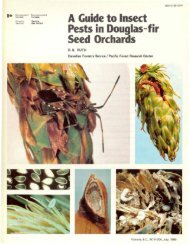Pacific Forestry Centre, Canadian Forest Service 506 West Burnside ...
Pacific Forestry Centre, Canadian Forest Service 506 West Burnside ...
Pacific Forestry Centre, Canadian Forest Service 506 West Burnside ...
Create successful ePaper yourself
Turn your PDF publications into a flip-book with our unique Google optimized e-Paper software.
matter in upland or wetland ecosystems (development<br />
of Folisols or Histosols) is due to conditions<br />
that restrict decomposition. These may include<br />
low temperatures, low oxygen and nutrient<br />
supply, excessive moisture, lack of earthworm<br />
activity, and the chemical composition of litter<br />
inputs (known as "litter quality"). The latter is a<br />
complex concept comprising nutrient content,<br />
organic composition, and physical toughness.<br />
The consequences of organic composition are<br />
poorly understood, but hard-to-decompose litter<br />
tends to be associated with high content of<br />
tannins, suberin (from bark), cutin (from leaves<br />
and fruits), and lignin from wood. Even celluose<br />
may be in this category, if highly crystalline and<br />
well protected by association with other<br />
components (Huang et al. 1998; Preston et al.<br />
2000), whereas sphagnic acid may have a specific<br />
inhibitory effect (Verhoeven and Toth 1995).<br />
NMR studies have consistently shown that<br />
decomposition in peat is associated with a relative<br />
increase in alkyl C (lipids, 0-50 ppm) and a<br />
decrease in 0- and di-O-alkyl C (60-110 ppm)<br />
mainly associated with polysaccharides. There<br />
may be a small accumulation of carboxyl C<br />
(including ami des and esters), but there is often<br />
little or no change in aromatic C (Hammond et al.<br />
1985; Preston et al. 1987; Preston et al. 1989;<br />
Holmgren et al. 1990; Norden et al. 1992; Baldock<br />
and Preston 1995). Thus, increases in "lignin"<br />
content indicated by PA may have much less to do<br />
with accumulation of aromatics than with<br />
accumulation of alkyl C-based components.<br />
Accumulation of lignin with high aromaticity in<br />
forest floor and Lignic Folisols is generally<br />
associated with large inputs of coarse woody<br />
debris (de Montigny et al. 1993; Fox et al. 1994;<br />
Preston et al. 1998; Preston 1999; Preston,<br />
Trofymow et al. n.d.). It was found by 13C CPMAS<br />
NMR analysis of a woody peat from Brazil (Freitas<br />
et al. 1999) and a peatified log from Indonesia<br />
(Bates et al. 1991). Charcoal is also a source of<br />
high aromaticity in organic matter (Preston,<br />
Trofymow et al. n.d.; Schmidt and Noack 2000),<br />
and thus may also influence some peat sites<br />
(Campbell et al. 2000).<br />
NMR spectra of organic matter fractions high<br />
in charcoal or lignin from highly decayed wood<br />
are shown in Figure 2. For the charcoal-rich<br />
sample, the prominent peat at 128 ppm comes<br />
from highly condensed aromatic structures and<br />
that at 30 ppm from the accumulation of alkyl C.<br />
The spectrum for lignin-rich samples includes<br />
characteristic lignin peaks at 148 ppm for phenolic<br />
C, 112-140 ppm for aromatic C, and 56 ppm for<br />
methoxyl C. Both spectra also have the main peak<br />
for cellulose-hemicellulose at 73 ppm and for the<br />
aromeric C-1 at 105 ppm.<br />
Research Needs for Climate Change Issues<br />
For climate change issues, filling the knowledge<br />
gaps in peat chemistry and decomposition<br />
will increase interdisciplinary cooperation.<br />
Peatlands hold vast amounts of C and factors<br />
controlling decomposition, DOC and methane<br />
release, and long-term C storage cannot be<br />
understood without reference to organic C<br />
chemistry. As noted earlier, much previous<br />
research on the C chemistry of peat and its<br />
decomposition pathways has been driven by<br />
issues surrounding the commercial use of peat or<br />
to provide insight into coal formation. Many of<br />
the detailed molecular-level studies only account<br />
for a very small fraction of the total C, and much<br />
chemical and isotope work has been from<br />
temperate or tropical peats. There are few studies<br />
providing the specific chemistry and process<br />
High charcoal<br />
High lignin<br />
ppm 200<br />
Figure 2.<br />
ro<br />
N<br />
100<br />
co<br />
LO<br />
Carbon-13 cross-polarization magic-angle<br />
spinning nuclear magnetic resonance<br />
spectra of charcoal-rich and lignin-rich<br />
samples of the 2- to 8-mm water-floatable<br />
fraction from 10-30 em depth of British<br />
Columbia coastal forests (project<br />
described in Preston, Trofymow et al. n.d.).<br />
o<br />
32<br />
In! Rep. NOR-X-383



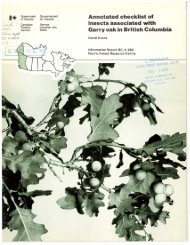
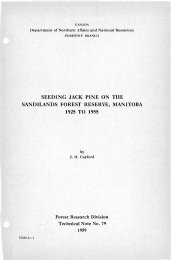
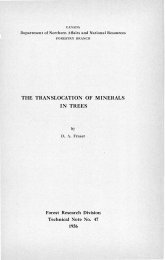


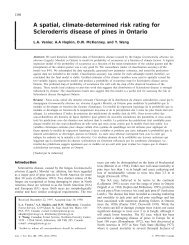

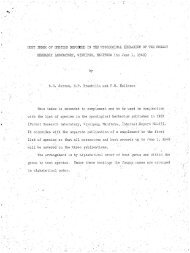
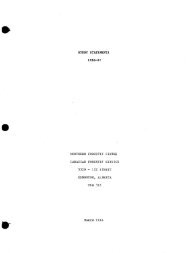
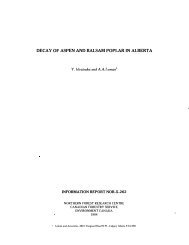
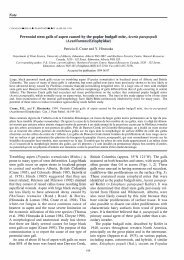
![Po],rell](https://img.yumpu.com/11946277/1/190x231/porell.jpg?quality=85)
